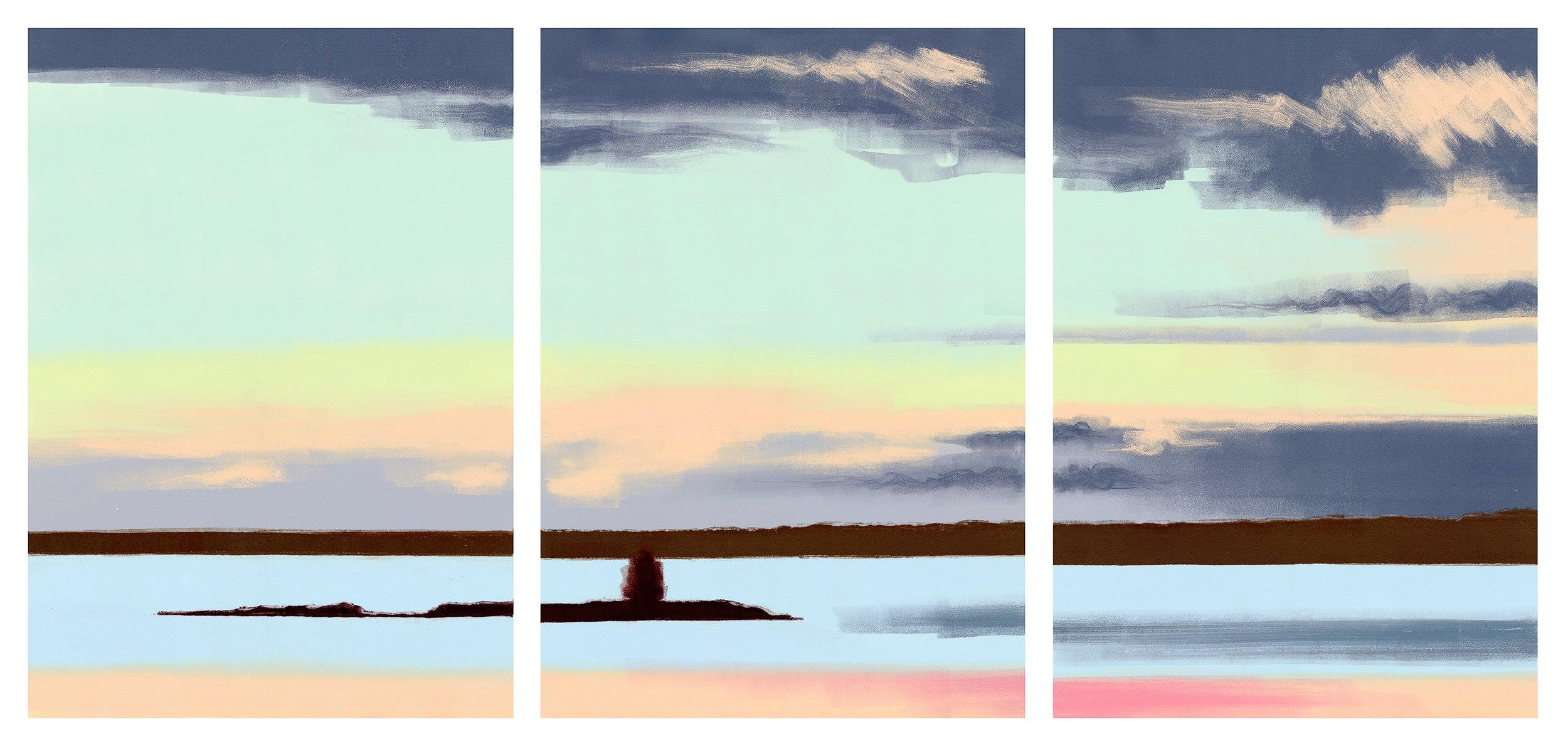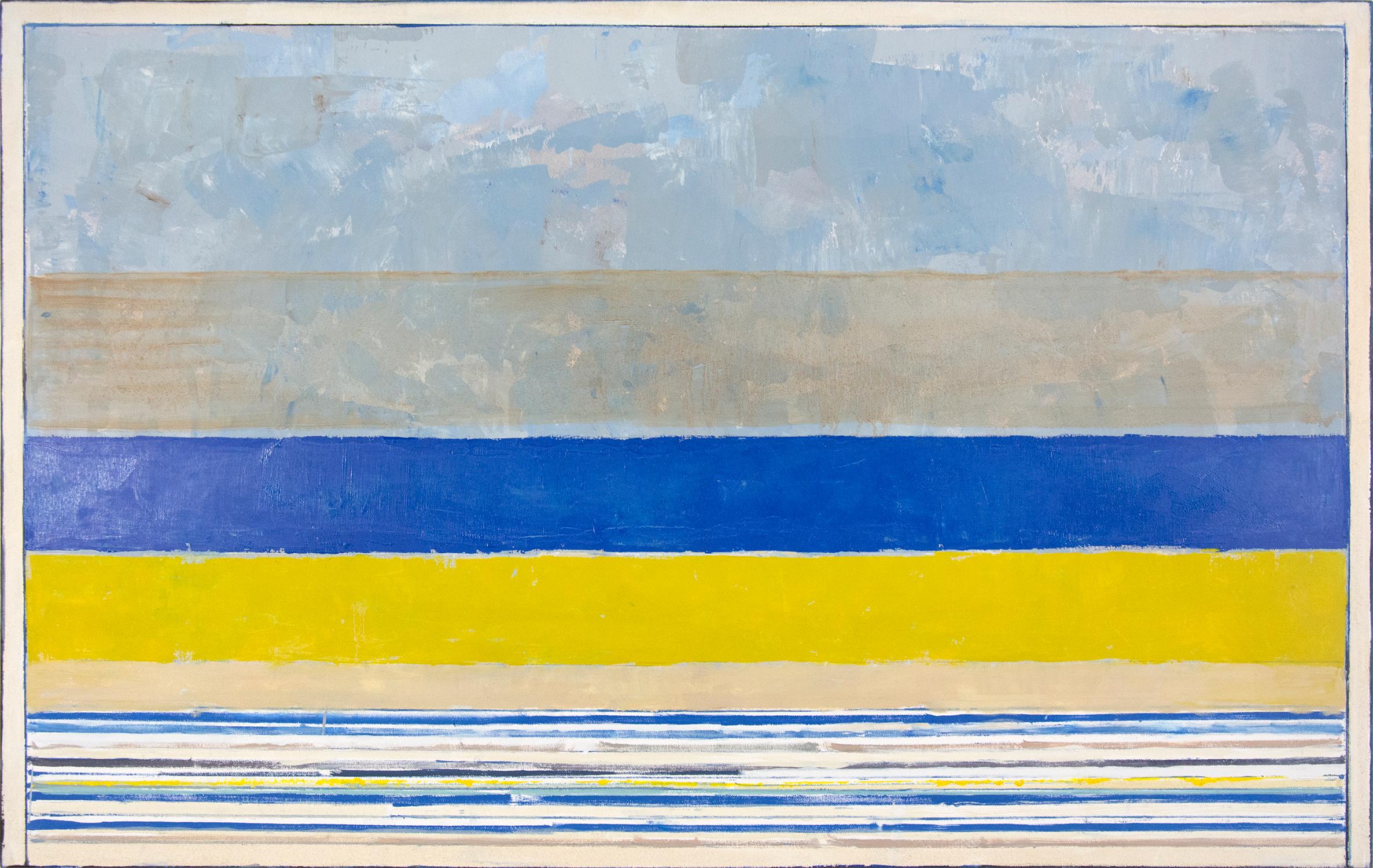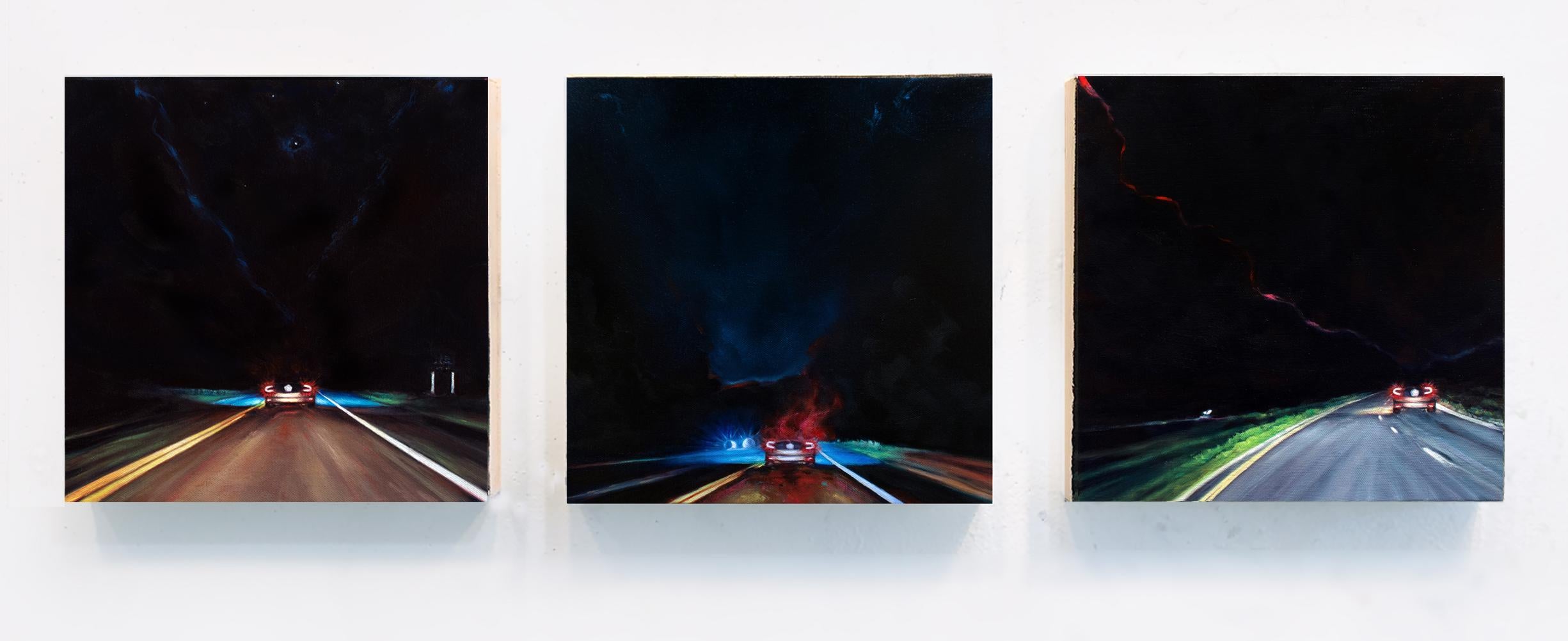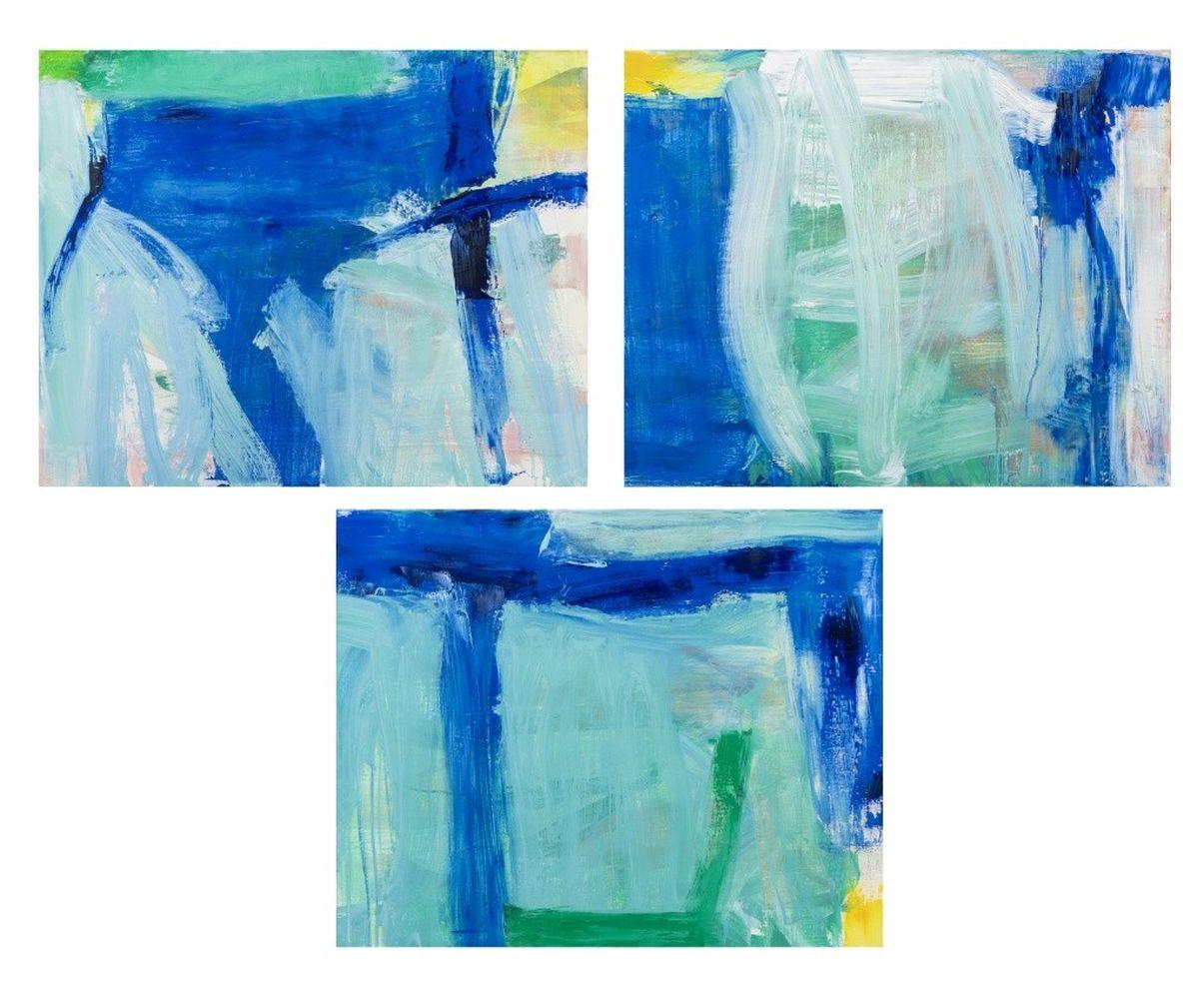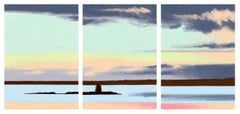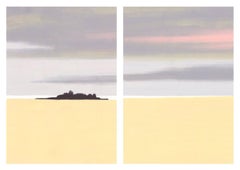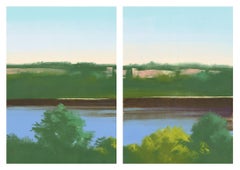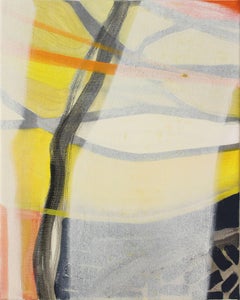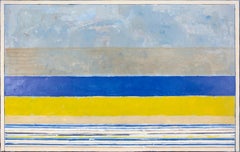Items Similar to Red Light, Landscape, Seascape, red, blue, green, yellow, dark colors, triptych
Want more images or videos?
Request additional images or videos from the seller
1 of 6
Rachel BurgessRed Light, Landscape, Seascape, red, blue, green, yellow, dark colors, triptych2023
2023
$5,400
£4,072.14
€4,709.62
CA$7,576.17
A$8,421.38
CHF 4,414.31
MX$102,845.49
NOK 55,110.11
SEK 51,848.33
DKK 35,151.24
About the Item
Monotype on three sheets of paper
Unframed
Rachel Burgess is a visual artist based in New York. Originally from Boston, she received a B.A. in Literature from Yale University and an M.F.A. in Illustration from the School of Visual Arts. Her interest in narrative and sequential forms continues to inform her work. She has been an artist in residence at Zea Mays Printmaking and the Schoodic Institute in Acadia National Park, and she was the recent recipient of a solo exhibition at the University of Connecticut. Other exhibition venues include IPCNY, the Monmouth Museum, the Katzen Art Center, the Newhouse Center for Contemporary Art at Snug Harbor and the Seoul Museum of Art.
- Creator:Rachel Burgess (American)
- Creation Year:2023
- Dimensions:Height: 39 in (99.06 cm)Width: 84 in (213.36 cm)
- Medium:
- Movement & Style:
- Period:
- Condition:
- Gallery Location:New York, NY
- Reference Number:1stDibs: LU16813936622
Rachel Burgess
Rachel Burgess is a visual artist based in New York. Originally from Boston, she received a B.A. in Literature from Yale University and an M.F.A. in Illustration from the School of Visual Arts. Her interest in narrative and sequential forms continues to inform her work. She is the recipient of a 2021 Artist Development Program Award from the International Print Center of New York (NY); previous solo/two-person exhibitions include 3S Artspace (NH), Susan Eley Fine Art (NY), the University of Connecticut Art Gallery in Stamford (CT) and the Jonathan Frost Gallery (ME); previous group exhibitions include the International Print Center of New York (NY), 20/20 Gallery at the Elizabeth Foundation for the Arts (NY), the Newhouse Center for Contemporary Art (NY), the Monmouth Museum (NJ), the South Bend Museum of Art (IN), the American University Museum (Washington, D.C.), the Pyramida Center for Contemporary Art (Israel) and the Seoul Museum of Art (Korea). Burgess’ work has been supported by residencies at Acadia National Park and Zea Mays Printmaking, and has been featured in the New York Times, the Boston Globe, Drawing Magazine, Introspective Magazine, 3x3 Magazine and CMYK. The coast of Maine has been the main source of inspiration for Rachel Burgess for many years. Using monotype, she creates iconic scenes that explore the relationship between experience and myth. By editing, abstracting, printing and reversing her landscapes, she gives physical form the process we perform internally when we convert our lives into stories. The results are places as seen through the mind’s eye, fabricated versions of real scenes. To make her work, Burgess begins by drawing outdoors, on location. She doesn’t use photographs because she wants to honor her instinctual editing choices, capturing her reaction to a place, rather than the place itself. Afterwards, in a print studio, she makes monotypes based on her drawings. Monotype is a form of printmaking that yields just one image. To make a monotype, Burgess applies oil-based ink to plexiglass plates, using rollers, Q-tips, tarlatan, paper towels and bits of cardboard to add and remove colors. The creation of the image must be accomplished in a day because the ink dries quickly. The pulling of the print, which takes a few minutes, is followed by a wiping away of the image from the plate. The initial “painting” is lost, and a new work on paper is created, mimicking the way we transform fleeting experiences into lasting stories. The final product is a mirror image of the original, a metaphor for the fictionalization and abstraction that occurs in our minds.
About the Seller
5.0
Vetted Professional Seller
Every seller passes strict standards for authenticity and reliability
Established in 2006
1stDibs seller since 2013
154 sales on 1stDibs
Associations
Association of Women Art Dealers
- ShippingRetrieving quote...Shipping from: Hudson, NY
- Return Policy
Authenticity Guarantee
In the unlikely event there’s an issue with an item’s authenticity, contact us within 1 year for a full refund. DetailsMoney-Back Guarantee
If your item is not as described, is damaged in transit, or does not arrive, contact us within 7 days for a full refund. Details24-Hour Cancellation
You have a 24-hour grace period in which to reconsider your purchase, with no questions asked.Vetted Professional Sellers
Our world-class sellers must adhere to strict standards for service and quality, maintaining the integrity of our listings.Price-Match Guarantee
If you find that a seller listed the same item for a lower price elsewhere, we’ll match it.Trusted Global Delivery
Our best-in-class carrier network provides specialized shipping options worldwide, including custom delivery.More From This Seller
View AllBlue Shadow, landscape, glue, gray, orange, pastel, seascape, nature, triptych
By Rachel Burgess
Located in New York, NY
Monotype on three sheets of paper
Unframed
Rachel Burgess is a visual artist based in New York. Originally from Boston, she received a B.A. in Literature from Yale University and an...
Category
2010s Contemporary Landscape Prints
Materials
Monotype
Yellow Dawn, landscape monotype
By Rachel Burgess
Located in New York, NY
Monotype print.
Category
2010s Contemporary Landscape Paintings
Materials
Archival Paper, Monotype
Hudson. 2018, green montoype on two sheets of paper. Diptych landscape.
By Rachel Burgess
Located in New York, NY
Rachel Burgess' landscapes are explorations of memory and the resonance of nature's forms. She begins her artistic process with plein air paintings and drawings which she completes i...
Category
2010s Contemporary Landscape Prints
Materials
Monotype, Paper
Rays of Light 3 (abstract, landscape, red, yellow, gray, sky, texture, stripes)
By Rachelle Krieger
Located in New York, NY
While Rachelle Krieger hints at elements of landscape across her canvases spherical shapes for rocks and boulders, dynamic lines climbing up and across the canvas for trees—she is re...
Category
2010s Contemporary Abstract Paintings
Materials
Linen, Oil, Acrylic
Rays of Light 1 (abstract, landscape, red, yellow, gray, sky, texture, stripes)
By Rachelle Krieger
Located in New York, NY
While Rachelle Krieger hints at elements of landscape across her canvases spherical shapes for rocks and boulders, dynamic lines climbing up and across the canvas for trees—she is re...
Category
2010s Contemporary Abstract Paintings
Materials
Linen, Oil, Acrylic
Lake View II, impressionistic landscape painting
By Katharine Dufault
Located in New York, NY
Artist Statement:
Painting is a meditation and a kind of alchemy in which I concentrate and transform my feelings and memories into something material that can be experienced in var...
Category
2010s Contemporary Landscape Paintings
Materials
Oil, Panel, Linen
You May Also Like
Places in My Soul 2 - quadriptych, Painting, Acrylic on Canvas
By Catia Goffinet
Located in Yardley, PA
There are secret places in our souls that we feel we don't know. The feelings that are born there never deceive us and embrace and welcome us. At times we feel that the only truly sa...
Category
21st Century and Contemporary Abstract Abstract Paintings
Materials
Acrylic
Triptych - bold, bright, colorful, abstract, modernist, tryptic oil on canvas
By David Sorensen
Located in Bloomfield, ON
Painterly bands of bright lemon, aqua, white and verdant green point to beach, sand and sky in this modernist triptych by David Sorensen.
Through his painterly modern compositions, celebrated Canadian painter David Sorensen (1937-2011) sought to “give voice to the inner reality.” In the paintings from his last years, Sorensen offers solutions to the nature of abstraction – wresting nature and the horizon from pure form and brilliant colour.
Born in Vancouver in 1937, Sorensen studied at UBC and the Vancouver School of Art under Arthur Erickson...
Category
Early 2000s Contemporary Abstract Paintings
Materials
Canvas, Oil
Ocean (triptych) - Abstract Landscape Original Painting
By Ivana Milosevic
Located in Los Angeles, CA
This one-of-a-kind 50 inch tall by 60 inch wide original triptych artwork is created by internationally collected Serbian artist Ivana Milosevic with...
Category
21st Century and Contemporary Impressionist Landscape Paintings
Materials
Canvas, Oil
$3,040 Sale Price
20% Off
Night Tripper Triptych - Set of 3 Landscape Paintings
By Edie Nadelhaft
Located in East Quogue, NY
"Night Tripper" Triptych - Set of 3 night driving road landscape paintings by Edie Nadelhaft - Oil on canvas.
Painting size: 12" x 12" inches (each)
I...
Category
2010s Contemporary Landscape Paintings
Materials
Canvas, Oil
$6,720 Sale Price
20% Off
Abstract Composition Triptych
Located in Astoria, NY
Robert O'Meara (American, XX-XXI), Abstract Composition Triptych, Oil on Canvas, turquoise and blue, each signed to verso, unframed. Panels: 16" H x 20" W; overall: 16" H x 60". Prov...
Category
21st Century and Contemporary Contemporary Abstract Paintings
Materials
Canvas, Oil
Abstract Composition Triptych
Located in Astoria, NY
Robert O'Meara (American, 1957-2024), Abstract Composition Triptych, Oil on Canvas, unsigned, with wood supports to top and bottom edges. Panels: 16" H x 12" W; overall: 17" H x 36" ...
Category
21st Century and Contemporary Contemporary Abstract Paintings
Materials
Canvas, Oil
More Ways To Browse
Rachel Green
Africa Maps By Emanuel Bowen
Andy Warhol Chanel Lithograph
Buckels Jim
Callahan Kevin
David Roberts Sphinx
Engraving Rossini
Graham Clarke
Ives Clock
John Le Keux
Montaut Lithograph
Phil Greenwood Limited Edition Etching
Vintage Ski Posters Chamonix
Virgil Thrasher
Colosseum Piranesi
Dali Butterfly Suite
David Roberts Petra
Earl Of Sandwich
